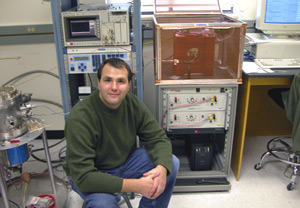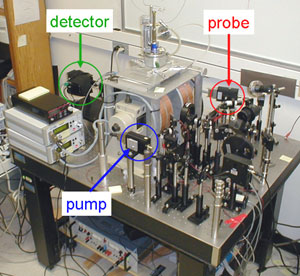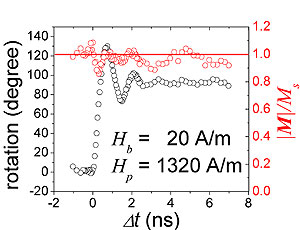Magnetodynamics 2005
Goals
 cryogenic and room-temperature pulsed inductive microwave magnetometers. |
This project develops instruments, techniques, and theory for the understanding of the high-speed response of commercially important magnetic materials. Techniques used include linear and nonlinear magneto-optics and pulsed inductive microwave magnetometry. Emphasis is on high-frequency (above 1 gigahertz), time-resolved measurements for the study of magnetization dynamics under large-field excitation. Research addresses the nature of coherence and damping in ferromagnetic systems and their effects on the fundamental limits of magnetic data storage. Research on spin-electronic systems and physics concentrates on spinmomentum-transfer oscillators (see section on Spin Electronics) and nuclear spin polarization in semiconductors. The project provides results of interest to the magnetic disk drive industry, developers of magnetic random-access memory, and the growing spin-electronics community.
Customer Needs
Advances in magnetic information storage are vital to economic growth and U.S. competitiveness in the world market for computer products and electronic devices. Our primary customers are the magnetoelectronics industries involved in the fabrication of magnetic disk drives, magnetic sensors, and magnetic random-access memory (MRAM).
Data-transfer rates are increasing at 40 percent per year (30 percent from improved linear bit density, and 10 percent from greater disk rotational speed). The maximum data-transfer rate in nanometric devices is currently 200 megabytes per second, with data-channel performance of over 1 gigahertz (in the microwave region), with corresponding magnetic switching times of less than 1 nanosecond. At these rates, a pressing need exists for an understanding of magnetization dynamics, and measurement techniques are needed to quantify the switching speeds of commercial materials.
The current laboratory demonstration record for storage density is over 30 gigabits per square centimeter (200 gigabits per square inch). How much further can longitudinal media (with in-plane magnetization) be pushed? Can perpendicular recording, patterned media with discrete data bits, or heatassisted magnetic recording extend magnetic recording beyond the superparamagnetic limit at which magnetization becomes thermally unstable? We are developing the necessary metrology to benchmark the temporal performance of new methods of magnetic data storage.
Use of polarized spins in semiconductors is a new direction in electronics that promises to revolutionize telecommunications and information processing. It is based on the manipulation and control of the quantum-mechanical spin of a semiconductor's charge carrier. It holds the promise of extending telecommunications frequencies into the terahertz regime. The frequency performance of conventional devices based on charge transfer is limited by electron velocities, charge-transfer times, and carrier mobilities, whereas the electron spin has no fundamental frequency limitation as long as coherence can be preserved. The electron-spin degree of freedom forms the most fundamental quantum oscillator.
Technical Strategy
Nanomagnetodynamics — Our technical strategy is to identify future needs in the data-storage and other magnetoelectronic industries, develop new metrology tools, and do the experiments and modeling to provide data and theoretical underpinnings. We concentrate on two major problems in the magnetic-data-storage industry: (1) data-transfer rate, the problem of gyromagnetic effects, and the need for large damping without resorting to high fields, and (2) storage density and the problem of thermally activated reversal of magnetization. This has led to the development of instrumentation and experiments using magneto-optics and microwave circuits. Microwave coplanar waveguides are used to deliver magnetic-field pulses to materials under test. In response, a specimen's magnetization switches, but not smoothly. Rather, the magnetization vector undergoes precession. Sometimes, the magnetization can precess nonuniformly, resulting in the generation of spin waves or, in the case of small devices, incoherent rotation. We use several methods to detect the state of magnetization as a function of time. These include the following:
- The magneto-optic Kerr effect (MOKE) makes use of the rotation of polarization of light upon reflection from a magnetized film. We have used MOKE with an optical microscope to measure equilibrium and nonequilibrium decay of magnetization in recording media.
- The second-harmonic magneto-optic Kerr effect (SH-MOKE) is especially sensitive to surface and interface magnetization. We have used SHMOKE for time-resolved vectorial measurements of magnetization dynamics and to demonstrate the coherent control of magnetization precession.
- In our pulsed inductive microwave magnetometer (PIMM), the changing magnetic state of a specimen is deduced from the change in inductance of a waveguide. This technique is fast, inexpensive, and easily transferable to industry. It may also be used as a time-domain permeameter to characterize magnetic materials. Since the development of the PIMM at NIST, similar systems have been built at several industrial research laboratories and universities.
While these instruments have immediate use for the characterization of magnetic data-storage materials, they are also powerful tools for the elucidation of magnetodynamic theory. The primary mathematical tools for the analysis of magnetic switching data are essentially phenomenological. As such, they have limited utility in aiding industry in its goal to control the high-speed switching properties of heads and media. We seek to provide firm theoretical foundations for the analysis of time-resolved data, with special emphasis on those theories that provide clear and unambiguous predictions that can be tested with our instruments.
Polarized Spins in Semiconductors — The spin precession of charge carriers in semiconductor hosts has significant potential for telecommunications applications. Unlike the case of conventional semiconductor switching, the frequency of spin precession is not fundamentally limited by the physical thickness of dielectric spacers. We are investigating optically generated spin populations in semiconductors and novel magnetic/semiconductor heterostructures of interest to the telecommunications industry. To enable future applications of polarized spins in semiconductors, such as ultrahigh-frequency oscillators, our goal is to obtain and measure coherent spin dynamics in metal/semiconductor heterostructures.
Recent advances in spin-based semiconductor devices have demonstrated that coherent spin precession can be maintained for hundreds of nanoseconds in III-V semiconductors and hundreds of microseconds in silicon. The precession frequency can be controlled by applied magnetic fields, gate voltages, and modulation doping techniques. Terahertz precession has been observed in Mn-doped InAs heterostructures with no applied magnetic fields. Modulation of the electron g-factor has been observed in the presence of electric fields that move the spin packets between regions of different g-factors, e.g., GaAs and AlGaAs.
We are investigating methods of measuring small numbers of spins in semiconductor devices and spin traps. Developing this metrology will be essential to the development of methods to control and manipulate small numbers of spins in a spin circuit. We have developed a pulsed-laser technique to pump and probe spin populations in semiconductors at cryogenic temperatures. The spin population is measured using the rotation of linear polarized light that is transmitted through a bulk sample. In addition to exploring spin dynamics in semiconductors, we are studying metallic devices that use spin-momentum transfer to induce coherent precession (see section on Spin Electronics).
Accomplishments
 Rotatable anisotropy Hk(0) for Permalloy, as a function of film thickness δ. The linear dependence on inverse film thickness is evidence that the rotatable anisotropy is a surface effect. The presence of such rotatable anisotropy enhances the bandwidth of ultrathin Permalloy layers, but at the expense of the susceptibility. |
- Surface Dependence for Rotatable Anisotropy — We found that there is a surface contribution to the rotatable anisotropy in Permalloy. Contributions to the magnetic anisotropy for which the magnetization direction itself is the source of symmetry breaking are generally categorized as "rotatable anisotropy." In a comprehensive study intended to determine the physical origins of rotatable anisotropy in single-layer Permalloy films, the pulsed inductive microwave magnetometer was successfully used to measure the anisotropy energy density as a function of magnetization angle. We found that the component of the energy density that is independent of magnetization angle is inversely proportional to film thickness, as expected if the source of the effect is associated with surfaces and interfaces. These results have significant implications for data storage applications, where the thickness of the magnetic sensor layer in a disk drive must be substantially reduced to accommodate higher areal densities of data.
- Nuclear Spin Reversal Using a Swept DC Field — We observed a reversal of nuclear spins in GaAs due to adiabatic cooling effects when an applied magnetic field is swept through zero. Nuclear polarization is generated by illuminating a GaAs sample with circularly polarized light from a laser diode. The steady-state nuclear polarization is altered by the nonequilibrium electron spin population excited with the laser diode. Detection of the nuclear spin polarization is achieved by monitoring the electron spin precession frequency shift due to the hyperfine effect. We found that the polarization of nuclei that were oriented in an applied field of 80 kiloamperes per meter was switched when the applied field was swept within the T1 time for the nuclear spin states. When the applied field is reduced on a scale shorter than the T1 time, the entropy of the nuclear spin system is conserved, requiring a reduction of the nuclear spin temperature. However, at sufficiently low nuclear spin temperatures, inter-spin interactions dominate and the nuclear spin temperature is minimized. The field at which the nuclear spin system depolarizes is a direct measure of the internuclear interaction strength. We have found that the interspin interactions are an order of magnitude greater than previously observed for p-doped GaAs. Efforts are now under way to determine whether these interactions are sufficient to induce a quantum phase transition at sufficiently low nuclear spin temperatures.
 Hyperfine field HN and effective nuclear temperature TN for dynamic nuclear polarization in GaAs. The hyperfine field is quenched near zero applied field, then reverses sign as field is swept through zero. These results indicate that the nuclear spin system is adiabatically cooled as the applied field is ramped to zero. The reversal of the hyperfine field is a direct result of the adiabatic nature of the measurement. |
|
|
|
- Pump-Probe Faraday Rotation Magnetometer Using Two Diode Lasers — A pump-probe Faraday rotation magnetometer using externally triggered pulsed diode lasers permits measurement of the dynamic properties of polarized electronic spins in semiconductors. The magnetometer may be operated in either continuous-wave (CW) or time-resolved modes. In CW mode, a spin polarization is created in the conduction band electrons of n-type GaAs by use of a circularly polarized CW laser. The change in Faraday rotation as a function of applied magnetic field enables measurement of the spin dephasing time T2*. In time-resolved mode, the dynamics of optically pumped spins can be directly observed at arbitrarily long pump-probe delays with a temporal resolution of 75 picoseconds and a spatial resolution of 25 micrometers. The maximum sensitivity is on the order of a thousand spins.
- Large-Angle Magnetization Dynamics Investigated by Vector-Resolved, Magnetization-Induced, Optical Second-Harmonic Generation — We examined the relationship between nonlinear magnetic response and the change in the Gilbert damping parameter α for patterned and unpatterned thin Permalloy (Ni80Fe20) films subjected to pulsed magnetic fields. An improved magnetization-vector-resolved technique based on the second-harmonic magneto-optic Kerr effect (SHMOKE) was used to measure magnetization dynamics after pulse field excitation. The magnetization excitations were achieved with pulsed fields that were aligned parallel to the hard axis of thin Permalloy films while a DC bias field was applied along the easy axis. At low-bias fields, α is inversely related to the bias field, but there was no significant reduction in the absolute value of the magnetization, as might be expected if there were significant spin-wave generation during the damping process. We discuss the discrepancies between data obtained by ferromagnetic resonance, where spinwave generation is prevalent, and pulsed field studies, and conclude that fundamental differences between the two techniques for the excitation of the ferromagnetic spin system might explain the different proclivity toward spin-wave generation manifest by these two experimental methods.
Award
- NIST Bronze Medal for development of Pulsed Inductive Microwave Magnetometer, 2004 (Tom Silva, Tony Kos, and Pavel Kabos).


